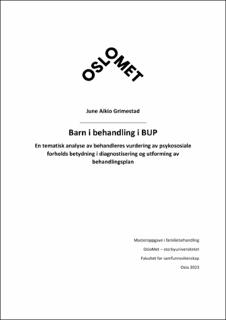| dc.contributor.advisor | Dahl Tyskø, Erna | |
| dc.contributor.author | Grimestad, June Aikio | |
| dc.date.accessioned | 2023-10-23T10:49:58Z | |
| dc.date.available | 2023-10-23T10:49:58Z | |
| dc.date.issued | 2023 | |
| dc.identifier.uri | https://hdl.handle.net/11250/3098031 | |
| dc.description.abstract | Masteroppgaven handler om hvordan psykologspesialister i poliklinikk i psykisk helsevern for barn og unge (BUP) vurderer avvikende psykososiale forhold hos barn. I diagnostiering og utforming av behandlingsplan bruker de diagnoseverktøy (WHO, 2008), og forholder seg til Helsedirektoratets veileder for poliklinikk (2008), samt prioriteringsveileder (2015). Hensikten med studiet er å synliggjøre hvilke mekanismer som kan ligge bak vurderingene av barns vansker som kommer til BUP. Studien er gjennomført med kritisk realisme som vitenskapsteoretisk ståsted som gir rammeverk for problemstilling, forskningsstrategi og drøftingens struktur. Problemstillingen er: «Hvordan beskriver psykologspesialister i BUP at avvikende psykososiale forhold rundt barnet tas med ved diagnostisering og i utforming av behandlingsplan?» Problemstilling er forsøk besvart gjennom innhentet teori og empiri. Empiri er innhentet gjennom en tre semistrukturert forskningsintervju av psykologspesialister ansatt i BUP. Gjennom kvalitativ analyse av empiri og drøfting av funn har jeg søkt etter faktorer og strukturer som påvirker informantenes vurdering. Resultatene fra studien blir presentert og drøftet i lys av teori fra den biopsykososial modell og systemisk familieterapi, samt forskning. Studien peker mot at informantene mener det er avgjørende å ta med avvikende psykososiale forhold i vurderingene og i behandlingsplanen. Denne planen må inngå i et tverrfaglig samarbeid og informasjon fra foresatte og samarbeidspartnere er viktig for vurderingen. Informantene lener seg mot den biopsykososiale modell i vurderingene. Analysen viser at det opprinnelige systemiske perspektiv av modellen, slik Engel presenterte den, er mindre fremme i vurderingen. Informantene peker på diagnoseverktøyets mangler som kompliserer bruken. Informantene synes å stå i et krysspress mellom styringsdokumenter, samarbeidspartnere og foresatte som har forventning om barnet skal få en psykiatrisk diagnose, og eget faglig ståsted der de barnets vansker kan forstås kun ut fra de avvikende psykososiale vansker. | en_US |
| dc.description.abstract | The master's focuses on how psychologist specialists in outpatient clinics in mental health care for children and young people (BUP) assess deviant psychosocial conditions in children. In diagnosing and designing a treatment plan, they use diagnostic tools (WHO, 2008), and refer e.g., to the Norwegian Directorate of Health's guidelines for outpatient clinics (2008), as well as prioritization guidelines (2015). The purpose of the study is to make visible which mechanisms may lie behind the assessments of difficulties of children who visit BUP. The study uses critical realism as a scientific theoretical point of view, which provides a framework for the problem statement, research strategy and the structure of the discussion. The problem statement is: "How do psychologist specialists in BUP describe how deviant psychosocial conditions in the environment the child lives in, are taken into account during diagnosis and in the design of a treatment plan?" The problem statement is discussed based on acquired theory and empirical findings. Empirical data is obtained through three semi-structured research interviews with psychological specialists in BUP. Through qualitative analysis of empirical evidence and discussion of findings, I have searched for factors and structures that influence the informants' assessments. The results from the study are presented and discussed based on theory from the biopsychosocial model and systemic family therapy, as well as research. The study revealed that the informants believe it is crucial to include deviant psychosocial conditions in the assessments and in the treatment plan. This plan is part of an interdisciplinary collaboration, and information from parents and partners is important for the assessment. The informants lean on the biopsychosocial model in their assessments. The analysis shows that the original systemic perspective of the model, as Engel presented it, is less present in the assessment. The informants point to the diagnostic tool's shortcomings which complicate its use. The informants seem to be in a cross-pressure between management documents, partners and guardians who have an expectation that the child will receive a psychiatric diagnosis, and their own professional point of view where they believe that the child's difficulties can only be understood based on the deviant psychosocial difficulties. | en_US |
| dc.language.iso | nob | en_US |
| dc.publisher | OsloMet-Storbyuniversitetet | en_US |
| dc.subject | Familieterapi | en_US |
| dc.subject | Tematisk analyse | en_US |
| dc.subject | BUP | en_US |
| dc.subject | Psykologi | en_US |
| dc.subject | Psykisk helse | en_US |
| dc.title | En tematisk analyse av behandleres vurdering av psykososiale forholds betydning i diagnostisering og utforming av behandlingsplan | en_US |
| dc.type | Master thesis | en_US |
| dc.description.version | publishedVersion | en_US |
